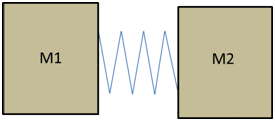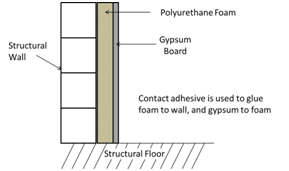Sound isolation for noise control in communications can be achieved through mass-spring-mass system. A mass-spring-mass system is accomplished by ‘floating’ an inner wall away from a structural wall. The amount of isolation that can be achieved using such a mechanism depends on the resonant frequency of the system. Typically, sound isolation can be realized down to about ![]() (1.4) times the systems resonant frequency. Near the resonant frequency, isolation can actually become worse due to the amplifying effect of the resonance. Therefore, in order to ensure isolation from even the lowest frequencies, 12 Hz is a good target to aim for.
(1.4) times the systems resonant frequency. Near the resonant frequency, isolation can actually become worse due to the amplifying effect of the resonance. Therefore, in order to ensure isolation from even the lowest frequencies, 12 Hz is a good target to aim for.
Figure 1: Mass-spring-mass system
The spring material can be of different materials including fibrous material, rubber blocks, polyurethane foam, or even shredded car tires among other things. The mass must be a dense and highly rigid material, such as gypsum board, chipboard, brick, or concrete. In the figure below, when the mass is set in motion (gypsum board), the force exerted on the spring (polyurethane foam) is resisted by the inertia of the second mass (the structural wall). Above the resonant frequency system, the spring will be heated by any vibrational energy and in return will dissipate this acoustic energy into thermal energy.
Weakening the spring can lower the resonant frequency as can increasing the mass attached to the spring. For example, if mineral wool was used as a spring material, changing the density from 100kg/m3 to 50kg/m3 would decrease the resonant frequency of the mass-spring-mass system by a ![]() factor. Using a heavy mass such as plasterboard can also lower the resonant frequency.
factor. Using a heavy mass such as plasterboard can also lower the resonant frequency.
Figure 2: Sound Isolation by ‘floating’ wall
Although increasing mass is important for sound isolation it is really the weight (mass x gravity) which is at work. This equates to the force on the spring from the mass due to gravity. The familiar equation is given by:
Fg = mg
Sound Isolation is a key ingredient to creating an effective sound room. Sound rooms are used for recording, testing, and creating. Controlled environments such as a sound room are essential when testing dsp algorithms and are an integral part of any acoustics laboratory.
More Information
References
[1] Newell, P., Recording Studio Design, 3rd ed., Focal Press, Burlington, MA, 2013.

